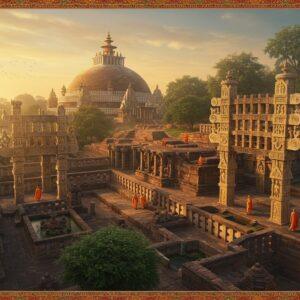
The Charaideo Maidams, often referred to as Assam’s pyramids, are ancient burial mounds steeped in history and cultural significance. These remarkable structures stand as a testament to the grandeur of the Ahom dynasty, which reigned over Assam for over six centuries. The unique architecture of these maidams draws comparisons to the pyramids of Egypt, highlighting their importance as royal tombs.
Delving into the History of Charaideo Maidams
The Charaideo Maidams trace their origins back to the 13th century, constructed by the Ahom kings as the final resting places for their royalty. These monuments reflect the Ahoms’ beliefs in the afterlife. Their architectural style showcases a captivating blend of indigenous Assamese and Southeast Asian influences, a testament to the cultural fusion that defined the Ahom dynasty. Charaideo, being the first capital of the Ahom dynasty, further underscores its historical importance. The religious and cultural rituals performed at these sites emphasize their sacred nature and profound impact on Assamese cultural identity and heritage.
The Legacy of the Ahom Royals
Journey back in time to the Charaideo Maidams, Assam’s own royal pyramids. These ancient burial mounds whisper tales of the Ahom kings who ruled Assam for more than 600 years. While pyramids often evoke images of Egypt, the Charaideo Maidams possess a similar majesty, reflecting the rich history and spiritual beliefs of the Ahom dynasty.
Unveiling the Story of Charaideo
-
Established in 1253 CE by the Ahom king Chao Lung Siu-Ka-Pha, Charaideo served as the first capital and held immense symbolic power for the Ahom rulers. The maidams became a powerful symbol, reflecting their profound belief in life after death. The Ahom royalty were laid to rest with their cherished belongings, meant to accompany them on their spiritual journey. Initially, burial was the common practice, but as Hinduism gained influence in the 18th century, cremation became the norm, with the ashes then enshrined within the maidams.
The very structure of the maidams is captivating, with underground chambers designed not only for the kings but also for their servants and even animals. The height and intricacy of each mound served as a testament to the power and stature of the king buried within. Skilled Assamese masons of the medieval era crafted these tombs with remarkable artistry, leaving behind a legacy for generations to admire.
Charaideo’s Cultural Impact
-
Charaideo is much more than just burial mounds; it represents a vibrant tapestry of rituals and cultural identity. Annual ceremonies are held here to honor the Ahom ancestors, fostering a sense of pride and continuity for the Assamese people today. These time-honored practices help preserve the rich oral traditions and folklore, ensuring that history lives on through generations.
Festivals and special events at Charaideo attract both locals and visitors, offering a chance to celebrate the diverse heritage of Assam. It’s a beautiful opportunity for cultural exchange, learning, and appreciation.
Planning Your Visit in 2025
-
If you’re planning a trip to the Charaideo Maidams in 2025, consider the best times to visit and the weather conditions to ensure a smooth and comfortable journey. You can access Charaideo through routes from major cities like Guwahati.
Nearby attractions, such as Sibsagar, offer glimpses into the remnants of the Ahom kingdom, adding depth to your experience. Local accommodations and dining options showcase the warmth of Assamese hospitality, promising a memorable stay. Dhekiakhowa Bornamghar: A Journey Through Time and Dhekiakhowa Bornamghar: Assam’s Spiritual Heart
provide deeper insights into Assam’s rich spiritual heritage.
Educational Value for UPSC Aspirants
-
For those preparing for the UPSC exams, the Charaideo Maidams hold particular educational significance. Understanding the history of the Ahom dynasty provides valuable insights for essay writing and interviews. These structures exemplify the rich diversity of India’s cultural heritage, a crucial aspect for competitive examinations.
Incorporating the knowledge of Charaideo Maidams into your study plan can greatly enhance your understanding of Indian history.
In July 2024, the Charaideo Maidams were bestowed with the prestigious title of India’s 43rd World Heritage Site by UNESCO. This recognition underscores their global importance, not just within Assam, but on the world stage.
Exploring the Charaideo Maidams opens a window into a world of history, culture, and architectural marvels. It’s an invitation to connect with Assam’s royal past and experience its enduring legacy.
Honoring Assam’s Heritage with Poojn
At Poojn.in, we offer a curated selection of puja items that resonate with the rich cultural traditions of Assam, including those observed at revered heritage sites like the Charaideo Maidams. Our products are designed to deepen your spiritual connection with these sacred places.
Traditional Offerings:
- Pure Cotton Gamcha: A traditional Assamese towel, perfect for temple visits and ceremonies. Discover our collection of Holy Clothing.
- Brass and Copper Utensils: For respectfully offering water during rituals.
- Natural Incense Sticks and Dhoop: Create a sacred atmosphere with fragrant incense.
- Fresh Flowers and Garlands: Enhance your offerings with the beauty of nature (available in select locations).
Prayer Essentials:
- Bell-Metal Items: Discover traditional Assamese bell-metal crafts.
- Earthen Lamps (Dia Bati): Illuminate your prayers with these beautiful lamps. Explore our handcrafted clay lamps.
- Pure Ghee: For lighting lamps and enriching rituals.
- Cotton Wicks: Essential for traditional lamp lighting. Find all your flammable puja needs here.
To order these items for your visit to Charaideo or other heritage sites:
- Visit: www.poojn.in
- Call: 03369029784
- WhatsApp: 9476142738
We offer pan-India delivery and guarantee authentic products sourced directly from trusted manufacturers. All our items are quality-assured and carefully packaged to maintain their purity.
Note: For bulk orders or special requests, please contact us 3-4 days in advance.
Embrace the Royal Heritage
The Charaideo Maidams stand as a powerful symbol of Assam’s rich royal heritage and the enduring legacy of the Ahom dynasty. A visit to these majestic burial mounds offers a unique opportunity to connect with history, immerse yourself in cultural traditions, and witness the exceptional artistry of medieval Assamese craftsmanship. As you explore this historical site, imagine the stories of the kings, their beliefs, and the vibrant culture that thrived under their rule.
In 2025, let your journey to the Charaideo Maidams be more than just a visit; let it be an enriching experience of learning and cultural exchange. Whether you’re a history enthusiast, a UPSC aspirant, or simply curious about India’s diverse heritage, these royal pyramids promise a fulfilling and memorable exploration. The UNESCO World Heritage Site recognition further emphasizes their importance, making them a must-visit destination for anyone seeking to discover the heart of Assam’s captivating past.
FAQs: Your Guide to Charaideo Maidams
What are Charaideo Maidams? The Charaideo Maidams are ancient burial mounds in Assam, serving as the final resting place for Ahom royalty. Their structure often leads to them being called “Assam’s pyramids.” They hold significant cultural and historical importance for the people of Assam.
What is Charaideo Maidam famous for? Charaideo is renowned as the first capital of the Ahom kingdom and the royal cemetery. It’s a powerful symbol of the dynasty’s 600-year reign and provides insights into their unique burial traditions and beliefs.
When was Charaideo Maidam built? Construction of the Charaideo Maidams began in the 13th century during the Ahom dynasty’s rule and continued for several centuries, reflecting evolving architectural styles and burial practices.
Why are Charaideo Maidams important? These maidams hold the remains of Ahom royalty, offering valuable insights into their culture, beliefs, and architectural skills. They also play a significant role in modern Assamese identity and cultural practices.
How can I visit Charaideo Maidams in 2025? You can travel to Charaideo district in Assam. Consider consulting travel guides or local tourism resources for information on routes, transportation options, and recommended times to visit. Local guides can enhance your experience by sharing historical insights and cultural context.
Are Charaideo Maidams listed in any competitive exams like UPSC? Yes, due to their historical and cultural significance, Charaideo Maidams are frequently referenced in competitive exams like UPSC. Understanding their history and relevance is beneficial for aspirants.
What should I expect to see at Charaideo Maidams? You’ll encounter a series of dome-shaped mounds, some with intricate carvings, set amidst the natural beauty of the Assam landscape. The site offers a glimpse into the artistic prowess of the Ahom dynasty and the tranquility of the region.
Is there any special preparation required to visit Charaideo Maidams? While no specific preparation is mandatory, it’s advisable to wear comfortable clothing and footwear suitable for walking. Familiarizing yourself with the history of the Ahom dynasty beforehand can significantly enrich your visit.


